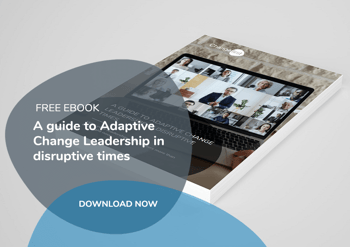In this post, we turn to take a close look at the importance of strong change leadership in developing and delivering on Agile promises and ambitions in your organisation.

With so much being redefined across our economic and political landscapes, delivering Agile is more of a target range than an end state. It’s about:
- being able to respond quickly and to successfully change things, while maintaining an engaged and motivated workforce
- balancing the demand for change (more projects, albeit smaller ones and the potential for overload) with the organisation’s capacity to deliver
- making the right decisions, and at the right time, to adapt, pivot and improve in an incremental way
- and also about leading a cultural change in the business itself
Delivering Agile is really about preparing for the unknown – gearing up to be as responsive as possible to significant levels of disruption, which are already upon us, but also the future of which will continue to be highly uncertain. It is this, all- encompassing, nature of Agile which means it can no longer be the sole preserve of a select band of specialists in the organisation. Agile Change is everyone’s business, and its style, pace and expectations are best modelled and legitimised at the C-suite level to permeate all aspects of an organisation or change initiative. Organisations are increasingly seeking people with adaptive capabilities, but it takes adaptive change leadership to:
- engage, empower and devolve appropriate power and authority to your teams
- see the value in building collaborative communities to solve problems
- understanding that change – and more so Agile change – is a “contact” sport
Mini Case Study by Marc Benioff (CEO of Salesforce) - Agile Change Leadership in action
This is best illustrated by giving consideration to a change leadership example in practice.
A few years ago, Marc Benioff showed how this heightened collaboration could be achieved using social media at Salesforce. Employees had already been using Chatter extensively and many of the people with critical connections to customer knowledge were adding the most value but were not even known to the leadership team.
Benioff was keen on leading cultural change and for leaders to craft a new leadership style and cultural approach that would loosen control but meant they wouldn’t lose control. He built this around 4 key thrusts that are recurring themes in any analysis of successful Agile change approaches:
- Leaders model collaboration themselves - valuing both learning and sharing goals (which encourage exploring opportunities to acquire knowledge from others), versus performance goals (which induce people to favor tasks that make them look good).
- Leaders attract and develop diverse talent - bringing people together from different backgrounds, disciplines, cultures and generations; rather than attracting talented employees only to subject them to homogenizing processes that kill creativity.
- Leaders play the role of the connector - in his best-selling book The Tipping Point, Malcolm Gladwell used the term “connector” to describe individuals who have many ties to different social worlds. It is not the number of people they know that makes connectors significant. It is their ability to link people, ideas, and resources that wouldn’t normally bump into one another. Leaders are the critical facilitators of collaboration.
- Leaders also balance hard and soft control - maintaining agility by directing teams, forming and disbanding as opportunities come and go. They also coach and support their teams when people get weary and as implementation gets difficult.
This is just one of a myriad of change leadership examples we could have selected but we feel it highlights some of the key issues at play.
Not all good change leaders are Agile Change leaders
Agile Change Leaders are the ones who can adapt – although we should caveat the fact that there are many good leaders in organizations who struggle to adapt and learn (especially from the failures) - and be ready for the next challenge.
And this is where agile with a small “a” and Agile with a big “A” collide: being agile is about taking decisions with (often) limited information but with a desire to experiment; expecting to use feedback from a varied audience; getting it wrong quickly and early, rather than failing spectacularly at the end.
Measuring Agile Change Leadership behaviours
These are the beliefs and the mindset that allow practice Agile change leadership behaviors to flourish.
Data from the Changefirst database highlights the global trend, based on responses from >5,000 change leaders as of January 2019. We place a strong emphasis on using people data to drive change decisions, and using people-centered tools to quickly gather, codify and extract meaning from the widest possible collaboration.
You can see the results below, from our Change Leader Assessment – the 3rd most popular of the change assessment tools available on Roadmap Pro – our digital change delivery platform. 
As you can see, averages from our global data would suggest that there is still some work to be done in the 5 key areas:
- Tracking
- Reinforcement
- Resourcing
- Modeling
- Creating an environment for Openness.
If these resonate with you as some examples of Agile Change leadership behavior, then how do you measure up? Are you creating the belief systems and processes for Agile Change Leadership behaviors to flourish?#

|
Download our Agile Change Management eBookTo find out.
|




Leave a comment